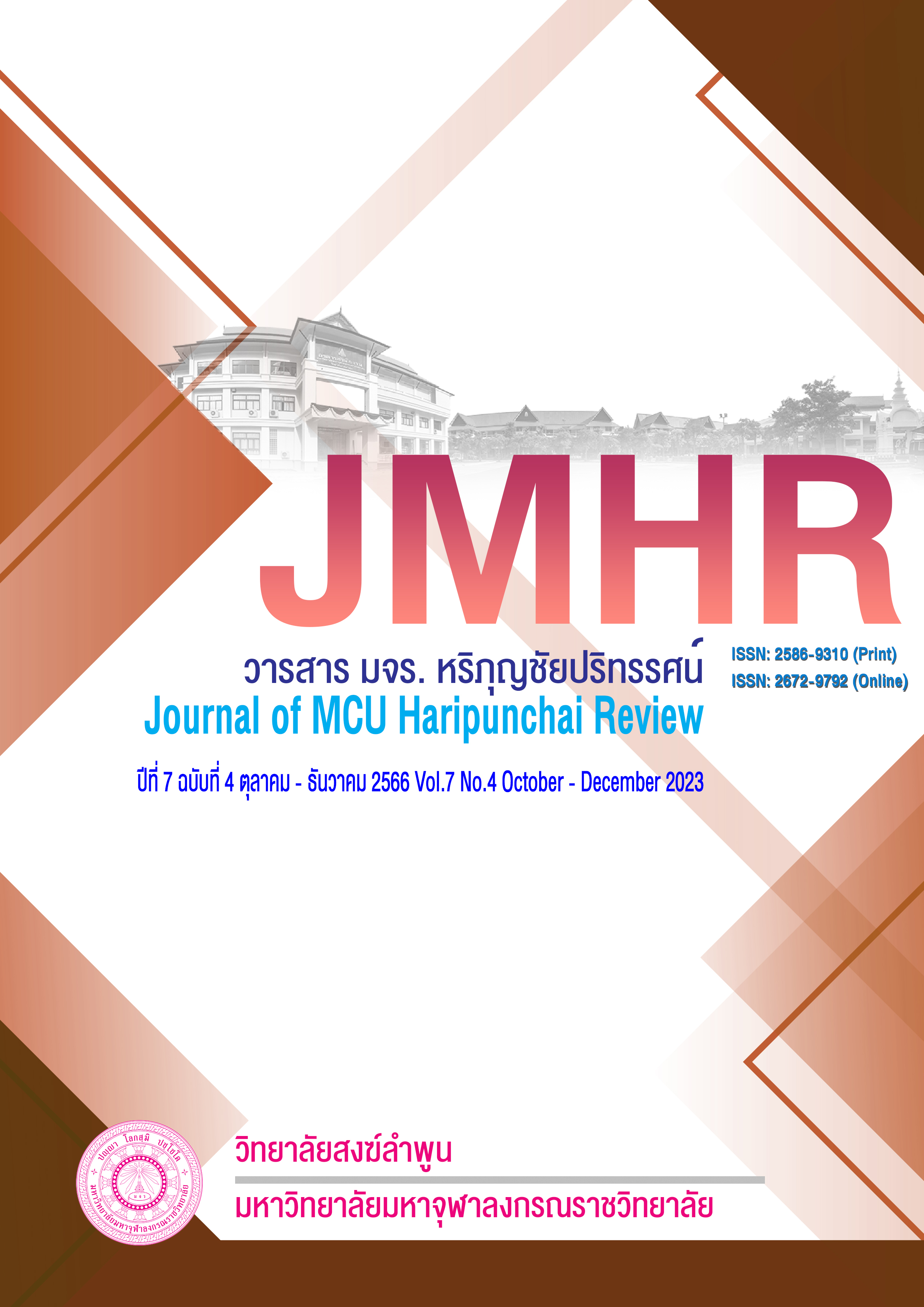THE DEVELOPMENT OF CREATIVE ARTS IN THE AREA PUBLIC COMMUNITY IN NORTHERN THAILAND
Main Article Content
Abstract
this research It has three objectives: (1) to study the creation of artistic works in the public spaces of tourist cities; (2) to develop participatory urban and community art spaces in Northern Thailand. (3) To develop the city to be a learning center and tourism of Buddhist art towards the community way of life in the north of Thailand. This research is an action research by creating works of art in the form of creating three-dimensional images (3D) on the walls of 7 public areas.
The results were found as follows: Results of the study revealed that art tourism cities in Japan and in European countries have an influence on the creation of art works on the public areas of modern Thai tourist cities, such as street art. Lampang City Municipality community wall art Lim Ko Niang Shrine, Pattani City, street art, “Nang Ngam Road”, Yala City Municipality and street art Songkhla
Works art creation in the public areas of tourist cities. by studying community history and local identity has led to the creation of works of art in the form of 3D images in 7 places: 1. Boon Yuen Village, Wiang Sa District, Nan Province 2. Mahachulalongkornrajavidyalaya University with Lamphun Campus, Mueang District, Province Lamphun 3. Ton Krai Village, Mueang District, Phrae Province 4. Lampang Luang Village, Mueang District, Lampang Province 5. Sri Don Chai Village, Pai District, Mae Hong Son Province 6. Wat Tha Kham Tai Village, Hot District, Chiang Mai Province 7. Taphan Hin Municipality Taphan Hin District Phichit Province
After that, the research team organized an activity to transfer knowledge in art (Art Workshop), i.e.a forum for exchanging knowledge among civil servants, academicians, artists, community leaders and villagers. to drive art works into tourist attractions and organized an activity called “Color Signs, Dream Points, Share Imagination” to educate young people about 3D art workshops. The use of mass media and information media to disseminate research findings and publicize community tourist attractions.
Article Details

This work is licensed under a Creative Commons Attribution-NonCommercial-NoDerivatives 4.0 International License.
References
ไชยสิทธิ์ ชาญอาวุธ. (2559). ศิลปะข้างถนนการแสดงออกบนพื้นที่สาธารณะ : ต่อเหตุการณ์สำคัญในสังคม Street Art Expression in Public Sphere : Important Social Circumstance. คณะมนุษยศาสตร์และสังคมศาสตร์ มหาวิทยาลัยราชภัฏธนบุรี.
ไชยสิทธิ์ ชาญอาวุธ และพัชราภา เอื้ออมรวนิช. (มปป.). การศึกษาคุณค่าด้านอัตลักษณ์ของศิลปะข้างถนนเพื่อการสร้างมูลค่าสู่เศรษฐกิจสร้างสรรค์.
ไชยสิทธิ์ ชาญอาวุธ. (2560). “ศิลปะข้างถนนการแสดงออกบนพื้นที่สาธารณะ:ต่อเหตุการณ์สำคัญในสังคม”.วารสาร มหาวิทยาลัยราชภัฏธนบุรี. 11 (2), 124 – 135.
เกษม เพ็ญภินันท์. (2552). ความโกลาหลของวัฒนธรรมศึกษา: ยกเครื่องเรื่องวัฒนธรรมศึกษา. กรุงเทพมหานคร : ศูนย์มานุษยวิทยาสิรินธร (องค์กรมหาชน).
รัตนา โตสกุล. (2548). มโนทัศน์เรื่องอำนาจ. กรุงเทพมหานคร : คณะกรรมการสภาวิจัยแห่งชาติ.
เสาวรภย์ กุสุมา ณ อยุธยา. (2553). “Creative Economy ทางเลือกใหม่ในการพัฒนาเศรษฐกิจไทย”. Executive Journal. 3 (1), 23 – 28.
เสาวรภย์ กุสุมา ณ อยุธยา. Creative Economy ทางเลือกใหม่ในการพัฒนาเศรษฐกิจไทย.http://www.bu.ac.th/knowledgecenter/executive_journal/jan_mar_10/pdf/23- 28.pdf. [1 ตุลาคม 2556].
Louis Bou. (2005). Street Art. The Spray File. New York: Colin Design.
ชะเอม สายทอง. (2551) “เพอร์สเปคทีฟ”. ก้าวทันโลกวิทยาศาสตร์. 8 (1), 1-7.
พรรณี วิรุณานนท์. (2551). “การพัฒนาแนวทางการจัดมหกรรมศิลปะร่วมสมัยนานาชาติในพื้นที่สาธารณะของประเทศไทย”. รายงานการวิจัย. กรุงเทพมหานคร: สำนักงานศิลปกรรมร่วมสมัย. .
ลิขิต กิตติศักดินันท์. (2559). “การถอดความหมายและบทบาทของศิลปะในที่สาธารณะจากภาพถ่ายที่ท่ามหาราช”. รายงานการวิจัย. กรุงเทพมหานคร: มหาวิทยาลัยศิลปากร.
แมนฤทธิ์ เต็งยะ. (2559) “จากวัฒนธรรมกราฟฟิตีสู่งานสตรีทอาร์ตในประเทศไทย”. Veridian E-Journal. Silpakorn University ฉบับภาษาไทย สาขามนุษยศาสตร์ สังคมศาสตร์ และศิลปะ. 9 (2), 2424-2436.
มานิตย์ โกวฤทธิ์ และประเสริฐ บุปผาสุก. (2562). ศิลปะเชิงพุทธสู่วิถีชุมชนบนผนังพื้นที่สาธารณะในจังหวัดเชียงใหม่. รายงานการวิจัย. สถาบันวิจัยพุทธศาสตร์ มหาวิทยาลัยมหาจุฬาลงกรณราชวิทยาลัย.
วันเฉลิม จันทร์พงษ์แก้ว. (2560). คุณค่าทางการสื่อสารและมูลค่าทางธุรกิจของสตรีทอาร์ท. กรุงเทพมหานคร: มหาวิทยาลัยกรุงเทพ.
ไชยสิทธิ์ ชาญอาวุธ. (2560). “การศึกษาคุณค่าด้านอัตลักษณ์ของศิลปะข้างถนนเพื่อการสร้างมูลค่าสู่เศรษฐกิจสร้างสรรค์”. วารสารวิชาการมนุษยศาสตร์และสังคมศาสตร์. 25 (49), 247 – 267.
ชุติมา บริสุทธิ์. (2557). การศึกษาการสร้างเมือง (machizukuri) ด้วยศิลปะร่วมสมัย ภายในเมือง Kanazawa จังหวัด Ishikawa. เชียงใหม่: มหาวิทยาลัยเชียงใหม่.
ณัฐกานต์ กันธิ. (2555). มะจิสุคุริ (Machitsukuri) กับการพัฒนาอุตสาหกรรมการท่องเที่ยว: กรณีศึกษาการพัฒนาอุตสาหกรรมการท่องเที่ยวในจังหวัดโออิตะ ประเทศญี่ปุ่น. เชียงใหม่: มหาวิทยาลัยเชียงใหม่.
วิมลสิทธิ์ หรยางกูร. (2011). “การสร้างสรรค์สภาพแวดล้อมชุมชนเมืองที่น่าอยู่อาศัย: ปัญหาที่มองไม่เห็นแลแนวทางแก้ไข”. วารสารวิจัยและสาระสถาปัตยกรรม/การผังเมือง. 8 (2). 9-10.


